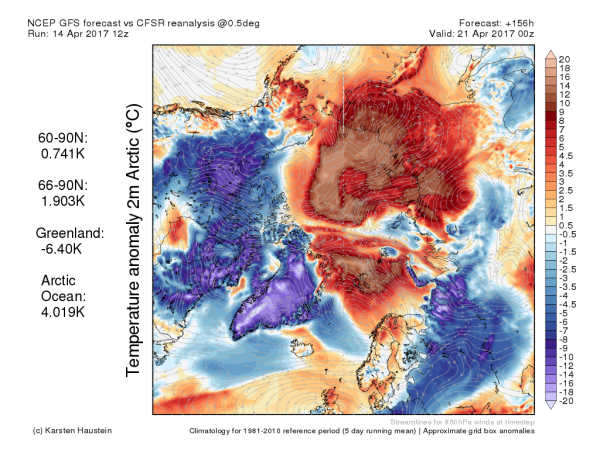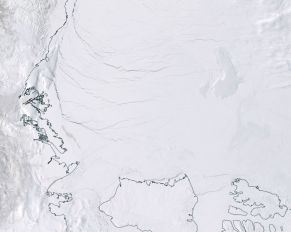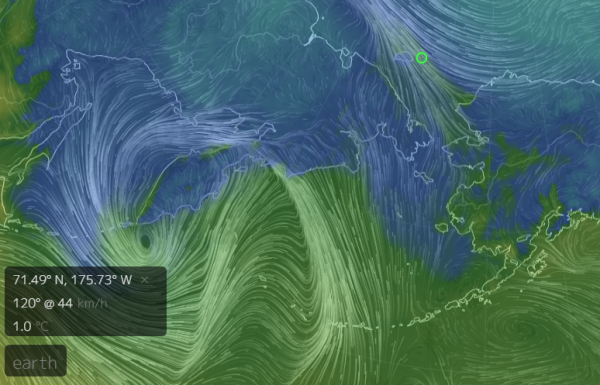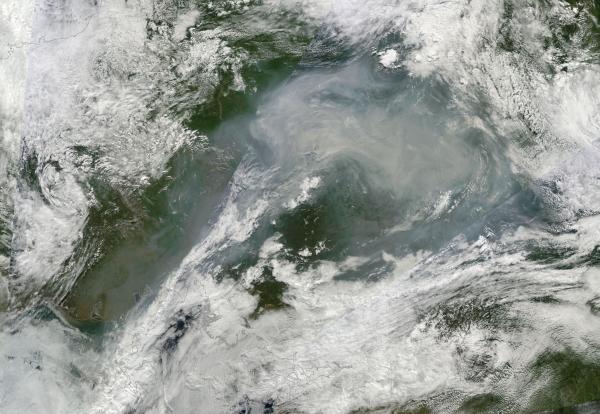Under
the Arctic Dome — Brutish High Pressure System is Wrecking the
Already Thinned Sea Ice
14
Apri7, 2014
There’s
a real atmospheric brute towering over the Arctic’s Beaufort Sea at
this time. A high pressure system that would put shame to most other
anti-cyclonic phenomena that bear the name. It is sending out a
broad, clockwise pattern of winds. It is pulling up warm air from the
Pacific to invade the Bering, Chukchi, East Siberian and Laptev Seas.
And its torquing motion is shattering the already considerably
thinned ice beneath it.
(A
powerful high pressure system over the Beaufort Sea is predicted to
further strengthen by late April 15. Image source: Earth
Nullschool.)
Clocking
in at 1046 mb of pressure, it makes typically strong 1030 mb high
pressure systems seem weak by comparison. Over the next day it is
expected to strengthen still — hitting 1048 mb by late April 15th
(coming very close to an extraordinary 1050 mb system).
Shattered
Sea Ice
This
powerful and strengthening system has already been in place for about
two weeks — slowly gaining momentum as its circulation has moved in
mirror to the waters of theBeaufort
Gyre that
swirl beneath it. Masked only by a veil of sea ice considerably
thinned by human-forced climate change, the waters of the Beaufort
are now breaking through. Streaks of dark blue on white in an early
break-up enabled both by a terrible Arctic warming and by this
powerful spring weather system.
(Side-by-side
images of Beaufort sea ice from April 4 [left frame] to April 13
[right frame]. Note the considerable and rapid advance of fracturing
in a relatively short period. For reference, bottom edge of frame in
both images is 500 miles. Image source: LANCE
MODIS.)
Warm
Storms
On
the Siberian
side of the Arctic,
this massive high pressure dome is drawing in warm winds from the
Pacific Ocean. Gust by gust and front by front, they come in the form
of squalls that deliver above freezing temperatures and rains that
blanket this thawing section of the Arctic. On Thursday, April 13,
these warm winds had driven northward over 2,500 miles of Pacific
waters to be drawn into storms that unleashed their fury — driving
rains and gales through the already dispersed ice in the Bering
Sea and
shattering ice floes through the Chukchi.
Today, April 14, these winds and rains drove northward to assault the
ice of the East
Siberian and Laptev seas.
(On
April 13, above freezing temperatures, rains, and gale force winds
ripped through the sea ice near Wrangle Island in the Chukchi Sea.
Image source: Earth
Nullschool.)
A
Great Atmospheric Stack Drawing Heat into the Arctic
In
the past, meteorologists like Stu
Ostro envisioned
that climate
change would tend to produce towering high pressure systems —
featuring increasingly strong storms roaring about their fierce outer
boundaries. And the massive high lurking over the Arctic at this time
is a good example of Ostro’s predictions coming to light in a
region that is very sensitive to human-forced warming.
This
great atmospheric stack appears to have had a considerable impact on
the ice already —helping
to push extent measures back into record low ranges by accelerating
the melt trend.
But these impacts are likely to spike over the coming week as this
powerful high expected to remain in place through the next five days
— continuing to draw warm air into the region. 

(Global
Forecast System models predict extreme warming over the Arctic Ocean
throughout the next week resulting from the influence of a powerful
high pressure system and very strong associated ridge in the Jet
Stream. Image source: NCEP
Global Forecast System Reanalysis.)
GFS
model runs indicate that average temperatures over the Arctic Ocean
region will hit a peak as high as 4 degrees Celsius above average by
late next week. Meanwhile, the warmest zones are expected to be as
much as 18-20 degrees Celsius above average. Such abnormal warmth at
this time of year, if it emerges, will put a considerable damper on a
freeze that should now be continuing in the High Arctic even as edge
melt ramps up with the progression of spring.
This
is particularly concerning due to the fact that temperature anomalies
in the Arctic tend to fall off during spring and summer. In other
words, such a powerful warming trend for the Arctic Ocean would be
bad enough during winter — but it is an even more unusual event for
spring. An ominous start to a melt season that could produce
far-reaching regional and global consequences.
Links:
Hat
tip to Colorado Bob
Hat
tip to Andy in San Dieg
The
Permafrost is Thawing 20 Percent Faster Than Previously Thought
14
April, 2017
Even
in a world at 1 to 1.2 C warmer than 19th Century averages the
permafrost is in trouble.
Already,
vast thawed lands are starting to release carbon dioxide and methane.
Thermokarst lakes bubble with the stuff. And pingos are now starting
to erupt as the ice relinquishes the soils of Siberia.
Russians, ironically
concerned about the safety of an oil and gas infrastructure that
helped to precipitate the warming in the first place,
are starting to install seismographs to detect these new
warming-induced eruptions from the thawed lands. Meanwhile, each new
summer brings with it ridiculously warm temperatures, never before
seen Arctic thunderstorms, and epic wildfires that rage over these
growing piles of peat-like carbon laid down during the course of
millions of years of glaciation — but now unlocked in just years
and decades by an unnatural thaw.
Permafrost
Thawing at 20 Percent Faster Rate Than We Previously Thought
Back
in the late 1800s, permafrost covered
about 17 million square kilometers of the Northern Hemisphere.
In less than 150 years, that extent has been reduced by 2 million
square kilometers due to the warming that has, to date, been produced
by fossil fuel burning and related carbon emissions. Even worse,
according to the new research, present
temperatures alone are enough to, this Century, push permafrost
coverage back to 12.5 million square kilometers.
That’s
about 1/4 of the world’s permafrost gone due to just 1 to 1.2
degrees Celsius of global warming.
(A
new study shows that 2 C worth of warming nearly cuts preindustrial
permafrost extent in half to around 9 million square kilometers.
Warming to 6 C above 1880s averages, which will occur so long as
fossil fuel burning continues, will wipe out nearly all of the
Northern Hemisphere’s permafrost. These thaw rates are about 20
percent more than previously estimated. Image source: An
observation-based constraint on permafrost loss as a function of
global warming.)
Warm
the world by just another degree Celsius to 2 C above 1880s averages
and, according
to the new research,
we’ll end up thawing another 3.5 million square kilometers of
frozen ground to an ultimately reduced area of around 9 million
square kilometers — cutting
the Northern Hemisphere’s original permafrost coverage nearly in
half.
Still
More Urgency For Rapid Cuts to Fossil Fuel Burning
This
newly identified permafrost thaw rate in response to human-forced
warming is much faster than previously expected — representing
a 20 percent acceleration compared to past permafrost thaw model
estimates.
And since the frozen ground of the world contains 1.2 to 1.4 trillion
tons of carbon locked away over the course of millions of years, so
rapid a thaw has big implications in a world warmed by fossil fuel
burning.
(Wildfires
burn through Siberia during August of 2014. Thawing permafrost lays
bare billions of tons of carbon that can then be subject to release
by microbes and the warming elements. Bacteria can break down the
carbon — releasing methane and CO2. Thawed permafrost also forms a
peat-like layer that can burn as more extensive fires rage across the
heating Arctic. Image source: LANCE-MODIS.)
Back
in 2015, scientists estimated that about 100
billion tons of permafrost carbon would hit the atmosphere over the
course of the 21st Century due to human-forced warming.
This warming feedback is equivalent to about 10 years of present
fossil fuel emissions. Add an estimated 20 percent extrapolated from
a faster than expected thaw to that rate and you end up with roughly
120 billion tons of carbon — or 12 years of present emissions
bubbling and bursting up out of that previously frozen ground
(approximately 40 ppm of CO2e heat forcing as feedback to the present
warming).
It’s
just another scientific finding of warming-related geophysical
impacts occurring on timescales that were faster than previously
expected. Still more added proof, as if we required any, that the
need for cutting human fossil fuel emissions couldn’t be greater or
more urgent. And
when seismographs are now being constructed to detect permafrost
methane bursts due to pingo detonations,
it’s becoming more and more clear that we do not want to
precipitate any more volatile Arctic thaw than we’ve already locked
in.
Links:
Hat
tip to Ryan in New England
Hat
tip to Wili
Hat
tip to Unnaturalfx









No comments:
Post a Comment
Note: only a member of this blog may post a comment.